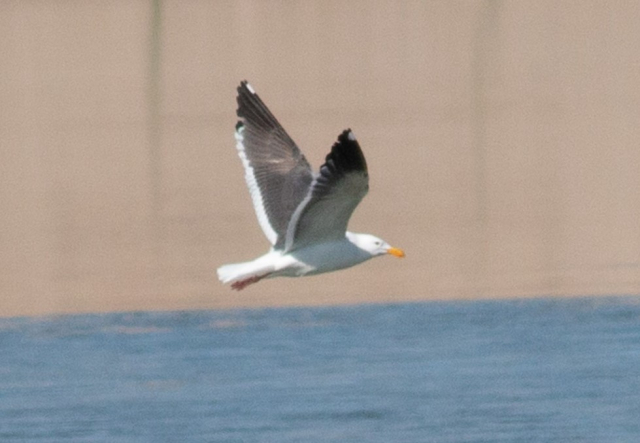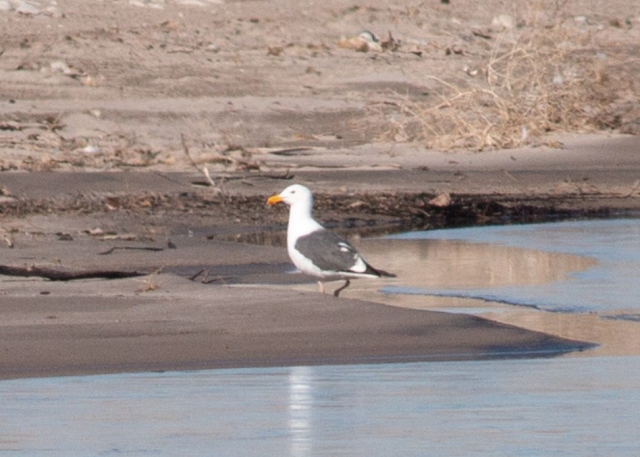Larus occidentalis
Status: Accidental in spring (Mlodinow, Brenner; Brogie 2024).
Documention: Photograph and description: 7 Apr 2023 Lake Minatare, Scotts Bluff Co (Mlodinow, Brenner; eBird.org).
Taxonomy: There are two subspecies (AviList 2025), occidentalis of the Pacific Coast from Farallon Islands north to northwestern Washington, and wymani of the Pacific Coast from Monterey Bay to Isla Guadalupe and south to central Baja California.
Western Gull hybridizes extensively with Glaucous-winged Gull on the Pacific Coast (Pierotti and Annett 2020).
Record: An adult was photographed by Steven Mlodinow at Lake Minatare, Scotts Bluff Co 7 Apr 2023 and described by Stephen Brenner as follows (Mlodinow, Brenner; eBird.org):
- Bulky generally, although not hulking. A little more beefy and upright than [Lesser Black-backed Gull], not longish attenuated shape I associated with [Lesser Black-backed Gull].
- Size just about [Herring Gull]. Photos of it near other gulls are distant but can see it is bigger than the piles of [Ring-billed Gull] but when next to [Herring Gull]. it almost appears a tad smaller. Very close in size to merganser.
- Dark mantle but not jet black and contrasts with much darker primary tips. Only 1-2 white mirrors on outer primaries in flight.
- Bubblegum pink legs. (should eliminate [Lesser Black-backed Gull] at any age). Bill rather bulky too for [Lesser Black-backed Gull]. Leg color very visible on flight shot 3, most profile shots, and the comparison shot with mergansers.
- Large white tertials and appears to be the white ‘skirt’ on folded secondaries.
Comments: One at Lake McConaughy, Keith Co 26 Apr 2021 (Mlodinow, eBird.org) was described as below, but the report was not accepted by NOURC as “lacking in substantive evidence for a first state record” (Brogie 2022), presumably a reference to the lack of a photograph. However, we include the description here pending review of the 2023 record. It is possible this individual was the same as that seen two years later in Scotts Bluff Co (see above). The details provided by the experienced observer read as follows:
“This was a bird nearing the end of its third cycle or in fourth cycle. The bill was moderately thick, but not as slim as typical of [Lesser Black-backed Gull] nor has hefty as many [Great Black-backed Gull]. The bill was yellow and not particularly bright. I could not see any dark markings, though a small spot could have been missed. There appeared to be a small orange gonydeal spot. The legs were pink. The head was white, without streaking, smudging, etc. Mantle was about as dark as that of an adult graellsii [Lesser Black-backed Gull] and not as dark as typical [Great Black-backed Gull] (or [Slaty-backed Gull]). When the bird was on the water, the back and wings looked entirely gray, but in flight, there was a brownish tinge to the gray of the wings, the exact distribution of which was not noted, but the outer 4 or so primaries were black and there were no white mirrors. There was a thick white trailing edge to the secondaries and onto inner primaries. Perched, the bird showed a small white scapular crescent and a broad white tertial crescent with a distinct white secondary “apron.” The tail was white with some smudgy gray distally on 1-2 rectrices on each side. The underwing coverts were white. The undersides of the outermost primaries were black (details of how extensive not noted), with smokey grayish underside of inner primaries and secondaries. In flight, the wings looked very much like the bird at https://macaulaylibrary.org/asset/182804081.The bird was bulkier and larger than nearby [Herring Gull], but not as huge as some [Great Black-backed Gull]. The wings, when perched, were proportionately shorter than that of [Herring Gull]/[Lesser Black-backed Gull]. [Great Black-backed Gull] was eliminated (not necessarily in order of significance) by presence secondary apron (which is usually absent in ]Great Black-backed Gull]), mantle darkness (not as dark as [Great Black-backed Gull]), and size. Bill shape seemed more like that of [Western Gull] as well. Additionally, [Great Black-backed Gull] with brown on their mantle typically already have white mirrors on their primaries, whereas this is not true of Western Gull. Bird was viewed for 20-30 minutes, perhaps more, mostly while it was perched. There was a modest wind and some heat waves, but prolonged viewing allowed for repeated clear views of the marks mentioned. There were multiple adult and young [Herring Gull] present as well as 7 [Lesser Black-backed Gull], one of which was an adult. The lighting was somewhat from behind me.”
There are several records of this Pacific Coast species in the Interior as far east as the Front Range of the Rocky Mountains from Wyoming south to New Mexico: Apr (2), Jun-Jul (4), and Sep-Nov (4) (eBird.org, accessed Apr 2023). Nearest of these to Nebraska were one in southeastern Wyoming Apr 2020, and eight in eastern Colorado: three in Jun-Aug, four in Oct-Nov, and one in Mar.
Photographs of a bird near Chadron, reported in eBird as a Western Gull 29 Aug 2013, were in fact of a Parasitic Jaeger (Brogie 2014).
Images
Abbreviations
NOURC: Nebraska Ornithologists’ Union Records Committee
Literature Cited
AviList Core Team, 2025. AviList: The Global Avian Checklist, v2025. https://doi.org/10.2173/avilist.v2025.
Brogie, M.A. 2014. 2013 (25th) Report of the NOU Records Committee. NBR 82: 131-146.
Brogie, M.A. 2022. 2021 (33rd) Report of the NOU Records Committee. NBR 90: 113-122.
Brogie, M.A. 2024. 2023 (35th) Report of the NOU Records Committee. NBR 92: 132-138.
Pierotti, R.J., and C.A. Annett. 2020. Western Gull (Larus occidentalis), version 1.0. In Birds of the World (A. F. Poole and F. B. Gill, Editors). Cornell Lab of Ornithology, Ithaca, NY, USA. https://doi.org/10.2173/bow.wesgul.01
Recommended Citation
Silcock, W.R., and J.G. Jorgensen. 2025. Western Gull (Larus occidentalis). In Birds of Nebraska — Online. www.BirdsofNebraska.org

Birds of Nebraska – Online
Updated 8 Sep 2025

